 Caria was a region of the Asia Minor situated south of Ionia and west of Phrygia and Lycia. The eponymous inhabitants were known as Carians, and came to Caria before the Greeks. The land was originally called "Phoenicia", because a Phoenician colony settled there in early times. Afterwards it received the name Caria from Kar, a legendary king of the Carians. Independent Caria arose as a "Neo-Hittite" kingdom around the 11th century BC, and was incorporated into the Persian Achaemenid empire as the satrapy in 545 BC. The most important town was Halicarnassus, from where its sovereigns reigned. Other major towns were Heraclea, Antiochia, Myndus, Laodicea, Alinda and Alabanda. The Iliad records that at the time of the Trojan War, the city of Miletus belonged to the Carians, and was allied to the Trojan cause.
Caria was a region of the Asia Minor situated south of Ionia and west of Phrygia and Lycia. The eponymous inhabitants were known as Carians, and came to Caria before the Greeks. The land was originally called "Phoenicia", because a Phoenician colony settled there in early times. Afterwards it received the name Caria from Kar, a legendary king of the Carians. Independent Caria arose as a "Neo-Hittite" kingdom around the 11th century BC, and was incorporated into the Persian Achaemenid empire as the satrapy in 545 BC. The most important town was Halicarnassus, from where its sovereigns reigned. Other major towns were Heraclea, Antiochia, Myndus, Laodicea, Alinda and Alabanda. The Iliad records that at the time of the Trojan War, the city of Miletus belonged to the Carians, and was allied to the Trojan cause.Mausolus was a satrap of Caria, between 377-353 BCE. The famed monument at Halicarnassus was dedicated to him by his wife, Artemisia, and became one of the Seven Wonders of the World. Caria was conquered by Alexander in 334 BC.
Legend
According to tradition, the Carians were named after eponymous Car, one of their legendary early kings (Herodotus, 1.171). Classical Greeks would often claim that Caria was originally colonized by Ionian Greeks, but it seems rather that the Carians were settled in the region before the Greeks. Homer records that Miletus (later an Ionian city) was a Carian city at the time of the Trojan War (Iliad, 2.865). Homer further records that the Carians joined the Trojans against the Achaeans (Iliad, 2.865).
History
Herodotus (1.171) recorded that Carians believed themselves to be aborigines of Caria. In his time, the Phoenicians were calling them "KRK" in their alphabetic script. This corresponds to the Karkiya or Karkisa mentioned in the Hittite records.
Modern lingustics supports that the Carian language was a descendant of the Luwiyan language, a linguistic branch of the Anatolian language family. Other Luwiyan offshoots include Lycian and Lydian. Carian inscriptions were deciphered in 1960s by Vitaly Shevoroshkin.
Bronze Age Karkiya aided the confederacy of Assuwa against Tudhaliya I. But later, in 1323 BC, Arnuwandas II was able to write to Karkiya for them to provide asylum for the deposed Manapa-Tarhunta of Seha River. The Karkiyans did so, and allowed Manapa-Tarhunta to take back his kingdom.
Unlike the Luwiyans in the Near East, the Karkiyans did not retain their literacy through the Dark Age. They next appear in records of the 8th century BC.
The Carians are clearly mentioned at 2 Kings 11:4 and possibly at Samuel 8:18, 15:18, and 20:23. Carians are also named as mercenaries in inscriptions found in ancient Egypt and Nubia, dated to the reigns of Psammetichus I and II.
They are sometimes referred to as the Cari / Khari. Carian remnants have been found in the ancient city of Persepolis or modern Takht-e-Jamshid in Iran.
Carians and Leleges
The Carians were often linked to the Leleges, but the exact nature of the relationship between Carians and Leleges remains mysterious. The two groups seem to have been distinct, but later intermingled with each other. Strabo (7.321; 13.611) wrote that they were so intermingled that they were often confounded with each other. However, Athenaeus (6.271) stated that the Leleges stood in relation to the Carians as the Helots stood to the Lacedaemonians.
This confusion of the two peoples is found also in Herodotus (1.171), who wrote that the Carians, when they were allegedly living amid the Cyclades, were known as Leleges.
More readings:
Caria, Frederic P. Miller, Agnes F. Vandome, John McBrewster, Paperback, English-language edition, Pages:114, Pub by VDM Publishing House Ltd.
Carian People: Mausoleum of Halicarnassus, Mausolus, Caria, Tissaphern...
Chasing ancient Carians, a police story...